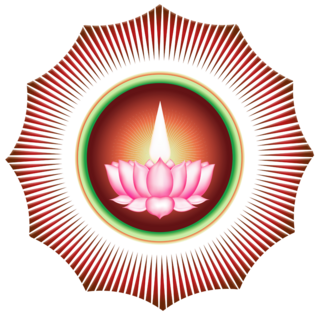
Ayya Vaikundar also known as Siva Narayana or Vaikunda Swami was the founder of the Ayyavazhi faith. The Ayyavazhis believe him to be the first and foremost Purna avatar of Eka-Paran and the god Vishnu (Narayana). As per Ayyavazhi mythology detailed in their scriptures, Ayya Vaikundar incarnated in 1833, when he rose from the sea of Tiruchendur in the mortal shell of Vaikundar.

Ayyavazhi is a Hindu denomination that originated in South India during the 19th century.

Pathi is the name of the primary centres of congregational worship for the South Indian religious system of Ayyavazhi, having a relatively large structure like that of a temple. They are seven in number.

Kroni is a figure in Ayyavazhi mythology. He is the primordial manifestation of evil, and manifests in various forms of evil, such as Ravana and Duryodhana, in different ages or yugas. To counteract and destroy the evil of Kroni's manifestations, Mayon incarnates as Avatars such as Rama and Krishna. He seems to be more evil than the demon Kali of the Mahabharata and Kalki Purana sharing similarities with Lucifer.

Dharma Yukam is the state of absolute bliss as per Ayyavazhi mythology. Dharma Yukam is described in the Akilam seventeen in Akilathirattu Ammanai. It is related to Dharmic moksha and to Abrahamic heaven.

The Arul Nool is a supplement to the Akilattirattu Ammanai, and is likewise considered a holy scripture of Ayyavazhi. This book contains the collection of messages given by Ayya Vaikundar to his Disciples, whose names are unknown. Since they are believed to be composed by Arylalarkar, it acquired the name Arulnool. There is no direct indication within the book regarding the time of its composition.

The following outline is provided as an overview and topic guide to Ayyavazhi:

Ayyavazhi rituals are the religious practices prevalent among the followers of Ayyavazhi. Most of them are connected with Akilam and Arul Nool and a few, though not associated with the holy books, are practiced for over a century right from the beginning of Ayyavazhi. Some practices are unique for Pathis and some others are common for all worship centres.

Ayyavazhi theology is the theology of a South Indian religious Faith and officially a sect of Hinduism known as Ayyavazhi. Several fundamental theological beliefs distinguish the Ayyavazhi tradition from Hinduism.

Thirunamam represents the 'Sacred name of God'. The phrase Namam also represents the white clay found at the deeper layer of earth, which is used as the powder to wear a flame shaped mark. The Ayyavazhi people wore this Namam, starting from the central point between the eyebrows, going straight up near the top edge of the forehead.

The Ayyavazhi includes a corpus of teachings of its initiator Lord Vaikundar in the form of instructions and slogans found in the religious book Akilathirattu.

According to the Ayyavazhi religious sect of Hinduism, the Ayyavazhi Trinity is the incarnation of God in the current stage of world development. Lord Vaikundar, the Incarnation, is the combination of the Ultimate God, Trimurti and Narayana. In Akilam immediately after the Incarnation of Vaikundar, he was viewed simultaneously as the Ultimate God, Narayana, and as son of Narayana. As per the earlier deed Narayana had to destroy Kaliyan, but due to the boons that kaliyan claimed Narayana has destroy him in form of Pantaram. And as per the promise made by Kaliyan, he would only be destroyed, if he give torture to any Pantaram. To overcome all these, such a unique way of Incarnation was planned.

The purpose of this chronology is to give a detailed account of Ayyavazhi from the beginning of the incarnational events of Vaikundar to the present time. Question marks on dates indicate approximate dates. A star (*) indicates the mentioning of that particular date in Akilam or Arul Nool. All dates but a few are found in the Tamil calendar and so doesn't coincide exactly with the months of the Gregorian calendar. The dates may span over any halves of the two consecutive months (Gregorian).

The Akilathirattu Ammanai the scripture of Ayyavazhi teaches Dharma on two different perspectives. One in sociology as charity and truth and another under spirituality to attain the stage of Oneness, unified into Lord Vaikundar. This state of ultimate oneness is called as Dharma Yukam or Dharma Pathi. Akilam also says that, Dharma is the only living wheel. The sociological way is asked to be followed by every one to attain the spiritual state of Dharma.

The ethics of Ayyavazhi are found scattered throughout the primary scripture, Akilathirattu Ammanai. They are also integrated with the meta-narrative mythography. However, regarding ethics, Arul Nool is considered as an accumulation and prophecy of the core concepts found in Akilathirattu. In Akilathirattu, the ethical abstracts are pointed out as "told by God" at several places at different situations to lesser god-heads, devas, saints etc. when asked by them.

Ayyavazhi phenomenology is the phenomenological variations found in Ayyavazhi society, worship centers etc. from their holy text Akilattirattu Ammanai.

Ayyavazhi beliefs are those associated with the South Indian religious faith known as Ayyavazhi. Some of the beliefs of Ayyavazhi are shared with that of Hinduism, and others are unique to Ayyavazhi.

The religious studies of Ayyavazhi are based primarily on the Ayyavazhi scriptures. Though there is enough knowledge there for a common worshiper to understand Ayyavazhi theology, it needs the Hindu and at some times the scriptures of other religions to be referred to undergo a detailed religious study on Akilam. Because Akilam maintains a unique type of relation with the other scriptures.
Vivekanandan Version is one among the release versions of Akilam. It was the only version released so far which includes the original source-text as well as the interpretations combainingly. It was named after the publication Vivekananada Pathippakam.
Vaikundar Thirukkudumbam Version (VTV) is one among the released versions of Akilam, the scripture of Ayyavazhi. It was named after the socio-religious welfare organisation Ayya Vaikundar Thirukkudumbam, which released it.





